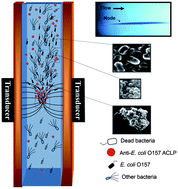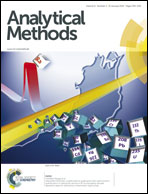Real-time monitoring of E. coli O157 and Salmonella enterica serovar Typhimurium in water using ultrasound and latex-based immunoassay†
Abstract
This study aimed at evaluating real-time, low-cost detection and quantification of bacteria, exemplified by E. coli O157 and Salmonella enterica serovar Typhimurium in aqueous systems. The approach takes advantage of the well-established latex-based immunoassay (LBI) and combines it with bacteria trapping and measuring using ultrasound. The results obtained demonstrate the utility of combining ultrasound standing waves of mean energy density 10 W cm−2, acoustic amplitude 100 kPa, and a laminar flow rate of the medium of 60 μl min−1 to trap selectively E. coli O157 or Salmonella enterica serovar Typhimurium (S. typhimurium) bacteria attached to 300–400 nm-antibody-coated latex particles. The ultrasound velocity measurements enabled a sensitivity down to 1.6 × 104 colony-forming units (CFU) ml−1 for E. coli O157 and 4.0 × 104 CFU ml−1 for S. typhimurium, compared to a sensitivity of 8.36 × 105 CFU ml−1 for E. coli O157 and 6.4 × 106 CFU ml−1 for S. typhimurium obtained by the standard LBI. The assay sensitivity can be further improved by use of various fluorescence methodologies.


 Please wait while we load your content...
Please wait while we load your content...